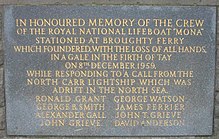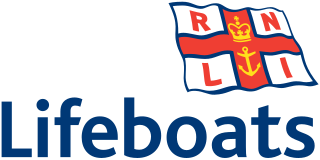
The Royal National Lifeboat Institution (RNLI) is the largest of the lifeboat services operating around the coasts of the United Kingdom, the Republic of Ireland, the Channel Islands, and the Isle of Man, as well as on some inland waterways.

The Penlee lifeboat disaster occurred on 19 December 1981 off the coast of Cornwall, England. The Royal National Lifeboat Institution (RNLI) lifeboat Solomon Browne, based at the Penlee Lifeboat Station near Mousehole, went to the aid of the vessel Union Star after its engines failed in heavy seas. After the lifeboat had rescued four people, both vessels were lost with all hands. Sixteen people died, including eight volunteer lifeboatmen.
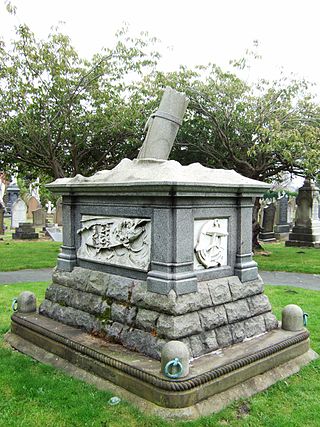
The Southport and St Anne's lifeboats disaster, commonly known as the Mexico disaster after the ship involved, occurred on the evening of the 9th December 1886. In all, 27 lifeboat men lost their lives trying to save the crew of the ship.
Since its inception, the Royal National Lifeboat Institution (RNLI) has provided lifeboats to lifeboat stations in the United Kingdom and Ireland.

Padstow Lifeboat Station has been at Trevose Head west of Padstow, Cornwall, since 1967. Before that it was at Hawker's Cove on the Camel estuary between the town and the sea. The lifeboat station is run by the Royal National Lifeboat Institution (RNLI), and since 2006 has been the base for Tamar-class RNLB Spirit of Padstow.

RNLB Mary Stanford was a Royal National Lifeboat Institution (RNLI) Liverpool-class pulling and sailing type lifeboat stationed in Rye Harbour.

North Carr is the last remaining Scottish lightship. She is 101 feet (31 m) in length, 25 feet (7.6 m) in beam and 268 tons.
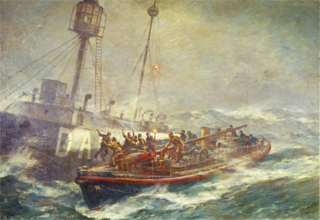
RNLB Mary Stanford was the Ballycotton Lifeboat from 1930 to 1959. Ballycotton is on Ireland's southern coast, a trade route to the Americas. There are many dangerous rocks and shallows with on-shore prevailing winds. Ballycotton has a long tradition of life-saving. Mary Stanford had 41 rescues, or "shouts", and saved 122 lives. She performed the notable Daunt Lightship rescue on 11 February 1936. After her withdrawal from service she lay for some years in a backwater of Dublin's Grand Canal Dock, but has now been returned to Ballycotton and restored.

Horton and Port Eynon Lifeboat Station opened in 1884 and was originally based in Port Eynon.

Appledore Lifeboat Station is the base for Royal National Lifeboat Institution (RNLI) search and rescue operations at Appledore, Devon in the United Kingdom. The first lifeboat was stationed in the town in 1825 and the present station was opened in 2001. It operates a Tamar-class all-weather boat (AWB) and an Atlantic 85 B Class inshore lifeboat (ILB).

Penlee Lifeboat Station is the base for Royal National Lifeboat Institution (RNLI) search and rescue operations for Mount's Bay in Cornwall, United Kingdom. The lifeboat station operated at various locations in Penzance from the early 19th century. It moved to Penlee Point near Mousehole in 1913, thus gaining its current name, but was moved to Newlyn in 1983 without any change of name. The station is remembered for the loss of the entire lifeboat crew on 19 December 1981.

Salcombe Lifeboat Station is the base for Royal National Lifeboat Institution (RNLI) search and rescue operations at Salcombe, Devon in England. The first lifeboat was stationed in the town in 1869. The Salcombe Lifeboat has twice capsized, in 1916 with the loss of 13 lives, and in 1983 with no loss of life. Since 2008 the station has operated a Tamar-class all weather boat (ALB) and an Atlantic 75 inshore lifeboat (ILB).

Aldeburgh Lifeboat Station is an RNLI station located in the town of Aldeburgh in the English county of Suffolk.
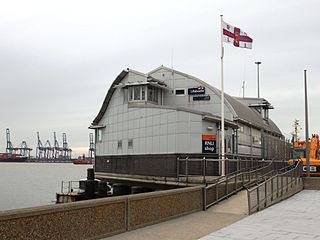
Harwich Lifeboat Station is a Royal National Lifeboat Institution (RNLI) station located in the town of Harwich in the English county of Essex. The station is positioned on the southern side at the mouth of the River Orwell estuary. The station serves a particularly busy section of coastline with Harwich being a very busy ferry terminal. Across the estuary is the Port of Felixstowe which is the United Kingdom's busiest container port.
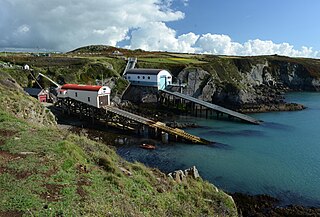
St Davids Lifeboat Station is a Royal National Lifeboat Institution (RNLI) station. It was opened in 1869 and to date has been involved in saving over 360 lives at sea in more than 420 launches. The station operates both an all-weather (ALB) and an inshore (ILB) lifeboat.

Eastbourne Lifeboat Station is a Royal National Lifeboat Institution (RNLI) lifeboat station in the town of Eastbourne in East Sussex. Founded two years before the RNLI was established, the station has operated continuously since 1822 and its lifeboats have been responsible for saving over 700 lives. There are two active lifeboat stations in Eastbourne, an all-weather station with the Trent-class 14-02 Esme Anderson at Sovereign Harbour and the D-class (IB1) The David H (D-876) at the inshore lifeboat station a couple of miles to the west at Fisherman's Green. An older lifeboat station, west of Eastbourne Pier, is now used as an RNLI museum.

Flamborough Lifeboat Station is a Royal National Lifeboat Institution (RNLI) lifeboat station located at Flamborough in the East Riding of Yorkshire, England. There used to be two lifeboat stations at Flamborough; one on the north side of Flamborough Head, and on one the south side. Since 1993, the village has just one lifeboat station on the southern side of Flamborough Head. The station operates a B-class Inshore Lifeboat Elizabeth Jane Palmer (B-820).

Whitby Lifeboat Station is a Royal National Lifeboat Institution (RNLI) lifeboat station located in Whitby, North Yorkshire, England. It is one of nine situated along the Yorkshire coast. Whitby has had a lifeboat station since 1802, with the RNLI responsible since 1861. In its 200 plus year history, Whitby has had five different lifeboat stations. A sixth lifeboat and station was located at Upgang, just up the coast from Whitby, and whilst it was considered separate from Whitby, it was crewed by men from the Whitby lifeboat.

Fraserburgh Lifeboat Station is located at the harbour town of Fraserburgh, in the NE corner of Aberdeenshire, Scotland.
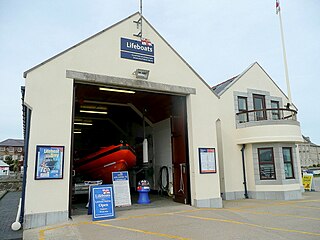
Beaumaris Lifeboat Station is located in the town of Beaumaris, on the Isle of Anglesey, in Wales.
